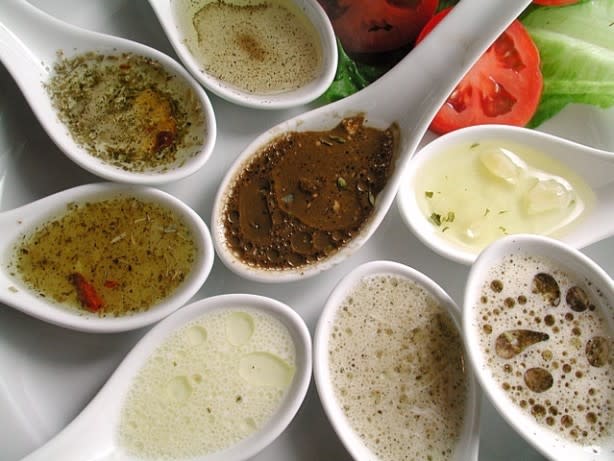
There is one recipe that is so simple, so quick and so easy that anyone can make it, even someone with no experience in the kitchen. This recipe is also one of the most versatile and useful. It is made with ingredients you’re likely to have in your kitchen and it is relatively inexpensive.
I am talking about vinaigrette, a fancy French name for basic salad dressing. It’s an incredibly handy item to have in your fridge during the summer, when you’re probably going to be making more salads.
You only need two ingredients: vegetable oil and vinegar. The recipe will take you only a couple of minutes to prepare, and once you’ve tasted your own homemade version and seen for yourself how easy it is, you probably won’t ever go back to bottled dressings. Commercial salad dressings, many of which are variations on vinaigrette, are loaded with preservatives and salt. They also don’t taste as fresh and delicious and they cost much more than homemade.
Here’s how to make vinaigrette: mix vegetable oil and vinegar together until they are well blended. You can whisk the ingredients in a small bowl, but I always use a clean jar that I’ve saved from used up jam or pickles; I pour the oil and vinegar into the jar, secure the top tightly and shake until it’s all mixed. I usually make more than I need for a particular recipe and store the leftovers in the fridge for the next time. This is the most basic mixture that I pour onto salads of all kinds – lettuce and other greens, tomatoes, cucumbers, cooked potatoes and so on and also main course dinner salads that I concoct using grains with vegetables and dairy (cold cooked barley, feta cheese, grilled mushrooms, cut up tomatoes and scallions, for example) or with meat (such as cold cooked couscous, chicken, grapes, peas and red onion).
Vinaigrette also comes in handy as a marinade. To make my meals tastier when I grill or broil, I frequently take whatever chicken, fish or meat I’m cooking for dinner and let it rest for an hour first in the dressing.
Although preparing vinaigrette is a cinch, the key to success is using the best vegetable oil and vinegar for a particular recipe, and in the right proportions. For a basic green salad, for example, any good olive oil will do, although extra-virgin olive oil, which comes from the first pressing of the olives, has the cleanest, purest flavor. But you can also use corn, canola, soybean or peanut oil. Each will give a slightly different flavor and if you make vinaigrette frequently, you can switch oils for variety.
The same goes for vinegar. Red wine vinegar is standard, but you might want to use white wine vinegar when you are making a dressing for a light colored dish such as potato or pasta salad or one made with chicken. Or substitute lemon juice for the vinegar, a nice choice for salads that contain fish. Rice wine vinegar is delicious for fish and rice salads, especially if you will be adding Asian style ingredients such as ginger, soy sauce or sesame oil. Balsamic vinegar is sweeter than other types and I think it is overused; my preference is to make Balsamic vinaigrette only as a marinade for beef or for hearty salads that contain beef. Apple cider vinegar is slightly sweet; I usually save it for dressings to go with cabbage (such as cole slaw), carrots and beets. Regular white vinegar has too sharp a taste for salad dressing.
Flavored vinegars are fine, but they can cost more. Why not add your own fresh flavor enhancers? Dijon mustard and garlic are classic additions. Or you can mix in chopped fresh herbs. Use whatever herbs please you, but some suggestions are: thyme leaves for chicken or turkey salad, basil-tomato salad, oregano-potato salad, dill-chopped salad. These are the simplest additions to basic vinaigrette, but you could go further by adding minced shallots, sun dried tomatoes, capers, paprika, anchovies, roasted red pepper, soy sauce, Worcestershire sauce and so on, to spike flavor. Or blend in a small amount of mayonnaise for a richer, thicker dressing.
The proportion of vegetable oil to vinegar in classic French vinaigrette dressing is 3 or 4 parts oil to one part vinegar, but I find that is somewhat greasy. We tend to like a more robust dressing, so I always heavy up on the vinegar. It’s less fattening that way too. The recipes I’ve given are in the proportions that we like in our family, but in your house, experiment a bit and add more or less oil or vinegar as suits the family taste buds.

Ronnie Fein has been a freelance food and lifestyle writer since 1980. She currently writes regular features for the food and community sections of daily newspapers and has written articles for Newsday, Cook’s Illustrated, Consumer’s Digest, Connecticut magazine, and many other publications. She operates the Ronnie Fein School of Creative Cooking in Stamford, Connecticut and is the author of three cookbooks, the most recent is
Hip Kosher (DaCapo, 2008).
The words of this author reflect his/her own opinions and do not necessarily represent the official position of the Orthodox Union.
